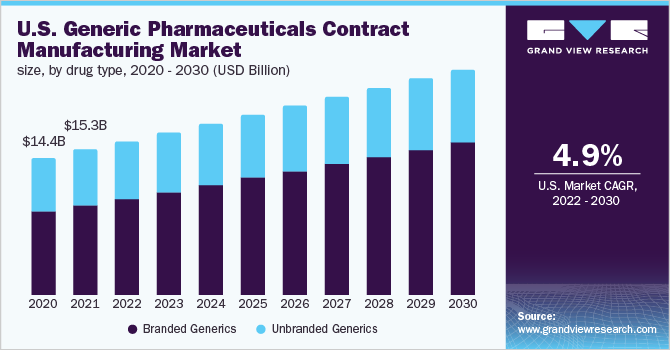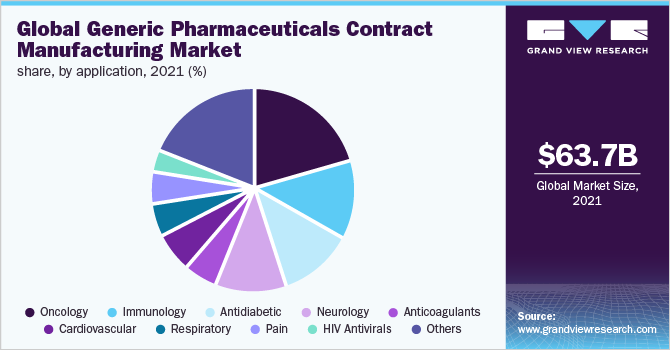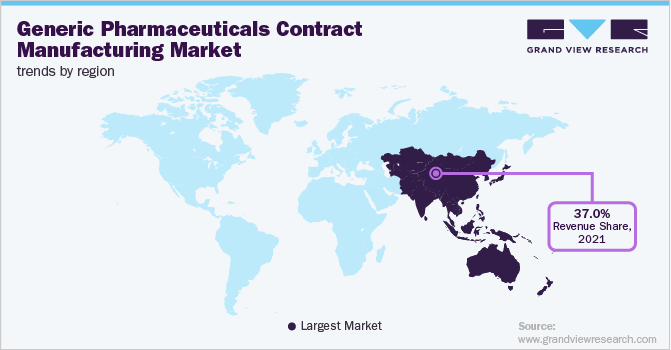- Home
- »
- Medical Devices
- »
-
Generic Pharmaceuticals Contract Manufacturing Market Report, 2030GVR Report cover
![Generic Pharmaceuticals Contract Manufacturing Market Size, Share & Trends Report]()
Generic Pharmaceuticals Contract Manufacturing Market Size, Share & Trends Analysis Report By Drug Type (Branded, Unbranded), By Product (API, Drug Product), By Route Of Administration, By Application, And Segment Forecasts, 2022 - 2030
- Report ID: GVR-4-68039-997-7
- Number of Report Pages: 100
- Format: PDF, Horizon Databook
- Historical Range: 2018 - 2020
- Forecast Period: 2022 - 2030
- Industry: Healthcare
Report Overview
The global generic pharmaceuticals contract manufacturing market size was valued at USD 63.7 billion in 2021 and is expected to grow at a compound annual growth rate (CAGR) of 5.8% from 2022 to 2030. An increasing number of government initiatives to promote generic products and the patent expiry of major drugs are some of the primary industry growth drivers. The COVID-19 pandemic moderately impacted the industry. During the initial months of the pandemic, the supply chain was disrupted due to stay-at-home orders by the government to control the spread of the virus. However, post-pandemic, manufacturing of generic drugs resumed for the prevention and treatment of the coronavirus.

For instance, in January 2022, 27 generic pharmaceutical manufacturers signed agreements with the Medicines Patent Pool to produce a generic version of the COVID-19 drug molnupiravir, to supply it in 105 low- and middle-income countries. Such agreements are expected to improve the demand for contract manufacturing and thus support market growth. The expiry of patent exclusivity of innovator drugs provides opportunities for generic manufacturers to introduce products at a reduced price. For instance, drugs, such as Feraheme, used in the treatment of anemia loss had exclusivity and a generic version of these drugs was launched in 2021. Such patent expiry of innovator drugs is going to create opportunities for generic drug manufacturing and thus support the industry growth across the forecast.
To address the growing demand for healthcare, regulatory authorities, such as the FDA, are improving access to generic drugs. For instance, the U.S. FDA, in 2020, signed a five-year grant with the University of Maryland and the University of Michigan to establish the Center for Research on Complex Generics. Such initiatives are expected to improve the development of generics and thus are expected to improve the demand for manufacturing in the coming years. The growing demand for cost-effective drugs has improved generic drug sales worldwide. According to the report by Evaluate Pharma, prescription generic drug sales accounted for USD 74.0 billion in 2020, and are expected to reach USD 99.0 billion by 2026. The rising sales of generic drugs are expected to improve the demand for generic drug contract manufacturing; thereby, boosting the industry growth post-pandemic.
Drug Type Insights
On the basis of drug types, the global industry has been further categorized into branded generics and non-branded generics. The branded generics segment dominated the global industry in 2021 and accounted for the largest share of more than61.50% of the overall revenue. The segment is anticipated to expand further at the fastest growth rate maintaining its dominant industry position throughout the forecast period. Branded generics are known for their superior quality and doctors usually use branded generics over unbranded, based on past experiences.
The unbranded generics segment is also expected to register a significant growth rate during the forecast period. Unbranded generics are generally cheaper than branded ones. Research published by the NCBI states that branded generics are over 13 times more expensive than unbranded generics, which is one of the key factors supporting the demand for unbranded generics. Unbranded generic drugs are equally safe and effective as branded generics. This is expected to boost their demand over the forecast period.
Product Insights
The API product segment dominated the industry in 2021 and accounted for the highest share of more than 55.70% of the overall revenue. Based on products, the industry has been divided into API and drug products. Growing demand for new geriatric drugs and patent expiry of exclusive small-molecule drugs are two of the key reasons boosting segment growth. Increased interest of public organizations in improving the production of API is further supporting segment growth. For instance, in March 2020, the Indian government set up a multiyear plan, in which, it invested USD 1.3 billion to boost the production of API in the country.
Such initiatives are expected to improve generic API contract manufacturing activities and hence contribute to segment growth. The drug product segment is expected to grow at a steady CAGR over the forecast period. Small molecule drug substances have become more complex, with manufacturing methods becoming more specialized. This supports the demand for a CMO for manufacturing drug products. The adoption of the expansion agreements by the CMO for drug product manufacturing is expected to further support segment growth in the coming years. For instance, in January 2022, Piramal Pharma Solutions added a development/commercial-scale roller compaction technology in its facility in Pennsylvania to expand its capabilities in manufacturing solid dosage forms.
Route Of Administration Insights
On the basis of routes of administration, the global industry has been further categorized into oral, topical, parenteral, and others. The oral route of administration segment dominated the industry in 2021 and accounted for the highest share of more than 59.3% of the overall revenue. The oral route is a self-administering route of administration and does not require a trained physician for drug administration, which is one of the major reasons for the high acceptance of oral formulations. Oral formulations are also considered more flexible in design and are majorly used in treating some common diseases, such as migraine, fever, infectious diseases, and diabetes.
These factors are supporting the demand for the oral route of administration. On the other hand, the parenteral segment is expected to register the fastest growth rate during the forecast period. The high bioavailability of injectable formulations leading to the immediate onset of action is the prime factor for its fastest growth. Apart from this, injectable formulations are preferred if the drugs are poorly absorbed. Moreover, the parenteral formulation is also primarily preferred in cases of medical emergencies, which is further driving the segment growth.
Application Insights
The oncology segment accounted for the highest share of more than 20.55% in 2021. Based on application, the industry is segmented into oncology, immunology, antidiabetic, neurology, anticoagulants, cardiovascular, respiratory, pain, HIV antivirals, and others. Cancer is one of the major causes of death worldwide. According to the World Cancer Research Fund International, over 18.1 million cases of cancer were reported in 2020. The American Cancer Society states that National Cancer Costs are expected to increase in the coming years. It states that spending on cancer care accounted for USD 200.7 billion in 2020 and is expected to rise to USD 245.6 billion by 2030 in America.

This increases the demand for cheaper alternatives like generic drugs for cancer treatment. The immunology segment is expected to grow at a significant CAGR over the forecast period. Immunological disorders include rheumatoid arthritis, Addison disease, psoriasis, Alzheimer's disease, and others. One of the major causes of these diseases is the growing geriatric population. Furthermore, immunological diseases require treatment for a long period. This increases the cost of medications and thus supports the demand for generic medications for treating immunological disorders. These factors are supporting the segment growth.
Regional Insights
The Asia Pacific region dominated the global industry in 2021 and accounted for the maximum share of more than 37.00% of the overall revenue. The region is estimated to expand further at the fastest growth rate maintaining its dominant position in the global industry throughout the forecast period as countries in the region have a GMP-regulated infrastructure for manufacturing drugs. Furthermore, the low costs of manufacturing eventually encourage various pharmaceutical companies in developed economies, such as the U.S., to outsource their manufacturing activities in this region.

This factor also helps boost the market growth in the Asia Pacific region. The North America region also accounted for a considerable share in 2021 and will grow further at a steady CAGR from 2022 to 2030. This can be attributed to the growth of the pharmaceutical industries in the U.S. and Canada. The presence of a large number of major players in this region is expected to contribute significantly to its growth. The growing focus of pharmaceutical companies in the region to outsource non-core operations, such as manufacturing, is further supporting the region’s growth.
Key Companies & Market Share Insights
The global industry is characterized by the presence of a large number of global and domestic companies. Regional expansions, partnerships, collaborations, and M&A activities are key strategies undertaken by most of these companies. For instance, in April 2022, Catalent, Inc. added a new high throughput ‘high-bay’ CGMP manufacturing suite at its facility in Missouri to produce oral solid dose forms. Some of the prominent players in the global generic pharmaceuticals contract manufacturing market include:
-
Jubilant Generics Ltd.
-
Recipharm AB
-
Siegfried Holding AG
-
Aurobindo Pharma
-
Cambrex Corp.
-
Alcami Corp., Inc.
-
Catalent, Inc.
-
Acme Generics Pvt Ltd.
-
Syngene International Ltd.
-
Pfizer CentreOne
-
Curia Global, Inc.
-
Metric Contract Services
Generic Pharmaceuticals Contract Manufacturing Market Report Scope
Report Attribute
Details
Market Size value in 2022
USD 68.1 billion
Revenue forecast in 2030
USD 106.9 billion
Growth rate
CAGR 5.8% from 2022 to 2030
Base year for estimation
2021
Historical data
2018 - 2020
Forecast period
2022 - 2030
Quantitative units
Revenue in USD billion and CAGR from 2022 to 2030
Report coverage
Revenue forecast, competitive landscape, growth factors, and trends
Segments covered
Drug type, product, route of administration, application, region
Regional scope
North America; Europe; Asia Pacific; Latin America; Middle East & Africa
Country scope
U.S.; Canada; U.K.; Germany; France; Italy; Spain; The Netherlands; Belgium; Sweden; Switzerland; Russia; China; India; Japan; Australia; South Korea; Malaysia; New Zealand; Philippines; Thailand; Singapore; Brazil; Mexico; Argentina; Colombia; Chile; South Africa, Saudi Arabia; Israel; Egypt; UAE
Key companies profiled
Jubilant Generics Ltd.; Recipharm AB; Siegfried Holding AG; Aurobindo Pharma; Cambrex Corp.; Alcami Corp., Inc.; Catalent, Inc; Acme Generics Pvt. Ltd.; Syngene International Limited; Pfizer CentreOne; Curia Global, Inc.; Metric Contract Services
15% free customization scope (equivalent to 5 analyst working days)
If you need specific market information, which is not currently within the scope of the report, we will provide it to you as a part of customization.
Pricing and purchase options
Avail customized purchase options to meet your exact research needs. Explore purchase options
Global Generic Pharmaceuticals Contract Manufacturing Market Segmentation
This report forecasts revenue growth at global, regional, and country levels and provides an analysis of the latest industry trends in each of the sub-segments from 2018 to 2030. For the purpose of this study, Grand View Research has segmented the global generic pharmaceuticals contract manufacturing market report on the basis of drug type, product, route of administration, application, and region:
-
Drug Type Outlook (Revenue, USD Billion, 2018 - 2030)
-
Branded Generics
-
Unbranded Generics
-
-
Product Outlook (Revenue, USD Billion, 2018 - 2030)
-
API
-
Drug Product
-
-
Route of Administration Outlook (Revenue, USD Billion, 2018 - 2030)
-
Oral
-
Parenteral
-
Topical
-
Others
-
-
Application Outlook (Revenue, USD Billion, 2018 - 2030)
-
Oncology
-
Immunology
-
Antidiabetic
-
Neurology
-
Anticoagulants
-
Cardiovascular
-
Respiratory
-
Pain
-
HIV antivirals
-
Others
-
-
Regional Outlook (Revenue, USD Billion, 2018 - 2030)
-
North America
-
U.S.
-
Canada
-
-
Europe
-
U.K.
-
Germany
-
France
-
Italy
-
Spain
-
The Netherlands
-
Belgium
-
Sweden
-
Switzerland
-
Russia
-
-
Asia Pacific
-
China
-
India
-
Japan
-
Australia
-
South Korea
-
Philippines
-
Malaysia
-
New Zealand
-
Singapore
-
Thailand
-
-
Latin America
-
Brazil
-
Mexico
-
Argentina
-
Colombia
-
Chile
-
-
Middle East & Africa
-
South Africa
-
Saudi Arabia
-
Egypt
-
Israel
-
UAE
-
-
Frequently Asked Questions About This Report
b. The global generic pharmaceuticals contract manufacturing market size was estimated at USD 63.7 billion in 2021 and is expected to reach USD 68.1 billion in 2022.
b. The global generic pharmaceuticals contract manufacturing market is expected to grow at a compound annual growth rate of 5.8% from 2022 to 2030 to reach USD 106.9 billion by 2030.
b. Asia Pacific dominated the generic pharmaceuticals contract manufacturing market with a share of 37.1% in 2021. This is due to the low manufacturing costs provided by countries such as China and India; this region eventually encourages pharmaceutical companies in developed economies to outsource their manufacturing activities to this region.
b. Some key players operating in the generic pharmaceuticals contract manufacturing market include Jubilant Generics Limited; Recipharm AB; Siegfried Holding AG; Aurobindo Pharma; Cambrex Corporation; Alcami Corporation, Inc.; Pacific Biolabs; Catalent, Inc; Acme Generics Pvt Ltd.; Syngene International Limited; Pfizer CentreOne; and Curia Global, Inc.
b. Key factors driving the generic pharmaceuticals contract manufacturing market growth include increasing government initiatives to promote generic products and the patent expiry of major drugs.
Share this report with your colleague or friend.
![gvr icn]()
NEED A CUSTOM REPORT?
We can customize every report - free of charge - including purchasing stand-alone sections or country-level reports, as well as offer affordable discounts for start-ups & universities. Contact us now
![Certified Icon]()
We are GDPR and CCPA compliant! Your transaction & personal information is safe and secure. For more details, please read our privacy policy.
We are committed towards customer satisfaction, and quality service.
"The quality of research they have done for us has been excellent."





